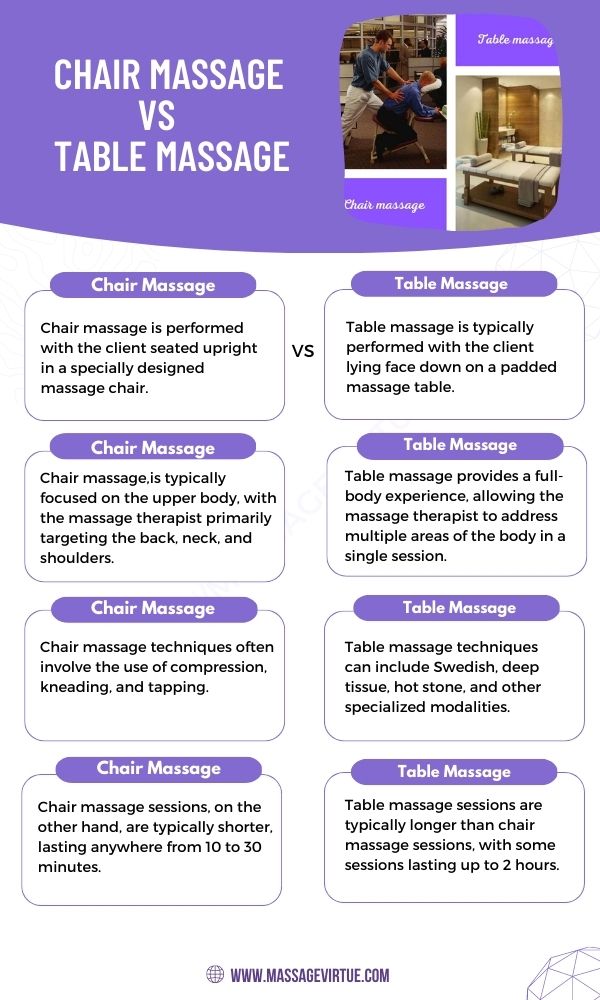Chair massage and table massage are two of the most common massage techniques used by massage therapists today. While both are aimed at providing relaxation, stress relief, and therapeutic benefits, they differ significantly in terms of their approach and techniques used.
Choosing the right massage technique for your individual needs is crucial, which is why it’s important to understand the differences between chair massage vs table massage.
In this article, we’ll compare and contrast the techniques used in chair massage vs table massage, and explore the unique benefits and drawbacks of each.
Techniques Used in Chair Massage
Chair massage is typically performed on a specialized massage chair, which allows the client to sit comfortably with their head, arms, and legs supported.
The massage therapist uses a variety of techniques to manipulate the muscles, including:
1. Compression: This technique involves applying pressure to specific areas of the body, such as the shoulders or lower back, to help release tension.
2. Kneading: This technique involves using the hands to knead and stretch the muscles, helping to relieve tightness and pain.
3. Friction: This technique involves using the fingers or palm to apply pressure to specific points on the body, helping to break up knots and adhesions.
4. Percussion: This technique involves using rapid tapping or chopping motions to stimulate circulation and increase energy levels
Benefits of Chair Massage
Chair massage is a type of massage that is typically performed on a specially designed massage chair, with the recipient fully clothed and seated upright. Here are some benefits of chair massage:
1. Convenience: Chair massage sessions are typically shorter than table massage sessions, making them a convenient option for those with busy schedules.
2. Cost-effective: Chair massage sessions are often less expensive than table massage, making them a great choice for those on a tight budget.
3. Accessibility: Chair massage is a portable and versatile technique, making it a great choice for those who may have difficulty lying down on a massage table.
4. Stress relief: Chair massage can help relieve stress and tension in the muscles, making it a great choice for those who are experiencing anxiety or depression.
Drawbacks of Chair Massage
While chair massage offers several benefits, there are also some potential drawbacks to consider:
1. Limited coverage: Chair massage may not provide as much coverage as table massage, as the massage therapist is typically focused on the upper body.
2. Discomfort: Some people may find the pressure of the massage chair uncomfortable or the position of the chair difficult to relax in.
Overall, a chair massage can be a great option for those looking for a quick, convenient, and cost-effective massage experience. However, it’s important to weigh the benefits and drawbacks before deciding if it’s the right technique for you.
Techniques Used in Table Massage
Table massage is typically performed with the client lying face down on a padded massage table, covered by a sheet or towel.
The massage therapist uses oil or lotion to help their hands glide smoothly over the skin, applying a range of massage techniques to various parts of the body. Here are some of the techniques used in table massage:
1. Effleurage: This technique involves long, sweeping strokes over the skin, helping to warm up the muscles and promote relaxation.
2. Petrissage: This technique involves kneading, squeezing, and pressing the muscles, helping to release tension and improve circulation.
3. Friction: This technique involves applying pressure to a specific area using the fingertips or palm, helping to break up knots and adhesions in the muscle tissue.
4. Tapotement: This technique involves rhythmic tapping or slapping of the muscles, helping to stimulate circulation and increase energy levels.
Benefits of Table Massage
Table massage, also known as Swedish massage, is a popular form of therapeutic massage that involves using long strokes, kneading, and circular movements on the body’s muscles. Here are some benefits of table massage:
1. Full-body Relaxation: Table massage provides a full-body experience, allowing the massage therapist to address multiple areas of the body in a single session. This can lead to deep relaxation and stress relief.
2. Pain Relief: Table massage can help alleviate pain and discomfort in the muscles and joints, making it a great choice for those with chronic pain conditions.
3. Improved Circulation: The techniques used in table massage can help improve blood and lymphatic flow, aiding in the removal of toxins from the body.
4. Increased Flexibility: Table massage can help increase flexibility and range of motion in the muscles, making it a great choice for athletes or those with mobility issues.
Drawbacks of Table Massage:
While table massage offers numerous benefits, there are also some potential drawbacks to consider:
1. Time Commitment: Table massage sessions can last anywhere from 30 minutes to 2 hours, depending on the client’s needs. This can be a drawback for those who are short on time.
2. Privacy Concerns: Some people may feel uncomfortable lying naked or partially clothed on a massage table, which can be a drawback of this technique.
3. Accessible: For some individuals, traditional table massages may not be easily approachable or accessible due to their inability to lie down comfortably for an extended period. This can be particularly challenging for individuals with medical conditions that affect their mobility, such as chronic pain, arthritis, or injuries.
Overall, table massage can be an effective way to relax, relieve pain, and improve overall well-being. However, it’s important to weigh the benefits and drawbacks before deciding if it’s the right technique for you.
Comparison of Chair Massage vs Table Massage
While both methods offer benefits, they have some fundamental differences that may make one a better choice for certain individuals. When it comes to comparing the techniques used in chair massage vs table massage, there are a few key differences to consider:
1. Coverage:
Table massage provides a full-body experience, allowing the massage therapist to address multiple areas of the body in a single session.
Chair massage, on the other hand, is typically focused on the upper body, with the massage therapist primarily targeting the back, neck, and shoulders.

2. Positioning:
Table massage involves lying down on a padded massage table, while chair massage involves sitting on a specialized massage chair. Some people may find one position more comfortable than the other, depending on their individual needs and preferences.
3. Techniques:
While both table massage and chair massage use a variety of techniques to manipulate the muscles, the specific techniques used may differ.
For example, table massage may involve longer strokes and deeper pressure, while chair massage may involve more compression and kneading.
4. Duration:
Table massage sessions are typically longer than chair massage sessions, with some sessions lasting up to 2 hours. Chair massage sessions, on the other hand, are typically shorter, lasting anywhere from 10 to 30 minutes.
Chair massage can be a convenient and cost-effective option for those looking for a quick massage experience, while table massage can provide a more comprehensive, full-body experience.
FAQs
1. How do I know which technique is best for me?
It depends on your individual needs and preferences. If you’re looking for a quick, targeted massage to alleviate upper body tension, a chair massage may be a good option.
If you want a more comprehensive full-body massage, a table massage may be a better fit.
2. Are there any contraindications for chair massage or table massage?
Yes, there are some contraindications for both techniques. If you have certain medical conditions or injuries, it’s important to consult with your healthcare provider before getting a massage. In general, chair massage is considered safer for people with certain conditions, such as pregnancy, while table massage may be contraindicated.
3. How long do chair massage and table massage sessions typically last?
Chair massage sessions are typically shorter, ranging from 10 to 30 minutes, while table massage sessions can range from 30 minutes to two hours or more.
4. How much do chair massage and table massage typically cost?
Prices vary depending on location, type of establishment, and other factors, but chair massage is generally less expensive than table massage.
Chair massage sessions can range from $1-$2 per minute, while table massage sessions can range from $60 to $150 or more per hour.
5. Do I need to undress for a chair massage or table massage?
For chair massage, you typically remain fully clothed and no oil or lotion is used. For table massage, you may undress to your comfort level and the massage therapist will use oil or lotion to massage your skin.
Conclusion
In conclusion, both chair massage and table massage offer unique benefits and drawbacks.
Chair massage is a convenient option for those who want a quick upper-body massage, while table massage provides a more comprehensive full-body massage experience.
When deciding which technique is best for you, consider your individual needs and preferences. No matter which technique you choose, it’s important to communicate with your massage therapist to ensure a safe and effective massage session.

